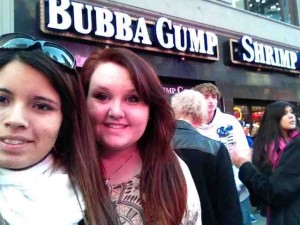The Eastern US Explorer tour is a great opportunity for Chinese students to tour the Eastern Seaboard of the United States. This tour is longer than most student tours, spanning a 10-12 day period, rather than just a four to seven days. The student tour was specifically designed for Chinese students to experience college tours of select U.S. universities, see cultural and historic sites in the Eastern United States and shop at some of the most desirable locations in New York City, Washington D.C. and other destination cities. Encompassing everything from camping and outdoor activities to visits to Harvard and Yale to the glamour of NYC and Broadway, this is a fully integrated cultural immersion tour students are guaranteed never to forget.
Fully guided tours of NYC and Boston provide firsthand look at American history
The adventure starts in Boston, with a day scheduled at Thompson Island Outward Bound. There, students will learn about the environment and experience the fun of the outdoors with the Trust and Self-Reliance program, which includes a ‘high ropes challenge’ and a ferry ride. Students will also take a guided tour of Boston’s Freedom Trail, which includes Boston Common, the State House, and the USS Constitution, famously known as ‘Old Ironsides.’ While in the Boston area, Chinese students will visit Walden Pond, made famous by Henry David Thoreau, and spend an afternoon at Plymouth Plantation on a reproduction of the world famous Mayflower ship, on which the pilgrims crossed. These activities will expose them to unique aspects of American history.
From Boston and surrounding areas, students will travel to New York City. The guided tour of the Big Apple includes trips to Madison Square Garden, Chinatown, Central Park, the Statue of Liberty and Ellis Island, NBC Studios, Wall Street and the New York Stock Exchange, the Empire State Building, and many other notable sites. Students will also experience the thrill of a night on Broadway, which includes dinner and a musical.
College Tours of Ivy League Universities and Top Name Schools
During the course of the trip, students will tour Harvard, Yale, Massachusetts Institute of Technology (MIT), New York University (NYU), Columbia University, and others. All tours include lunch and/or opportunities to sit in on classes. A full portrait of the academic landscape is presented, including an opportunity to see what typical day-to-day life at various campuses is like. At Harvard, students will lunch with others in the freshman residence hall. At NYU, they will request to sit in on a business or women’s studies class. At Columbia University, they’ll attend a journalism or marketing class. And at Yale, they’ll have the opportunity to meet with the Yale-China Association and the SOM Program for Social Enterprise.
Exploring Humanitarian, Social, and Environmental Causes
Exposure to different aspects of existence is essential to education. So, students will have the opportunity to volunteer at a NYC soup kitchen or homeless shelter. They will also volunteer at a retirement center or senior home. Interacting with others in these environments will provide students with a chance to see sides of American life that is not immediately visible to a traveler, and to develop a deeper appreciation for the value of service to others. Students will also visit Honey Brook Organic Farm in New Jersey, where they will have the opportunity to learn about sustainable living.
The final leg of the tour will be in Washington, D.C.—a visit that will include a full tour of the US Capitol. Student tour leaders will also be given the opportunity to schedule a visit with a U.S. Senator or Congressman, up close and in person. And they’ll enjoy an Illuminated tour of Memorials and Monuments, which includes the Lincoln, Jefferson, Vietnam, World War II, and Korean memorials, among others. They will also visit the Supreme Court and the Smithsonian Museums, and may tour the White House, depending upon availability.
Chinese Student Travel in the U.S.
The U.S. Explorer Tour has been consistently described by students and educators as the ‘ultimate’ tour for students wanting to be introduced to America’s educational system, history, and culture. By being fully comprehensive and interactive, it has served to help students acclimate to U.S. culture more easily, and provided a vivid and unforgettable portrait of what academic and cultural life in the U.S. is like.





